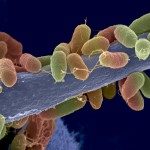Link to Pubmed [PMID] – 12748390
Proc. Natl. Acad. Sci. U.S.A. 2003 May;100(11):6860-5
After pollen grains germinate on the stigma, pollen tubes traverse the extracellular matrix of the style on their way to the ovules. We previously characterized two pollen-specific, receptor-like kinases, LePRK1 and LePRK2, from tomato (Lycopersicon esculentum). Their structure and immunolocalization pattern and the specific dephosphorylation of LePRK2 suggested that these kinases might interact with signaling molecules in the style extracellular matrix. Here, we show that LePRK1 and LePRK2 can be coimmunoprecipitated from pollen or when expressed together in yeast. In yeast, their association requires LePRK2 kinase activity. In pollen, LePRK1 and LePRK2 are found in an approximately 400-kDa protein complex that persists on pollen germination, but this complex is disrupted when pollen is germinated in vitro in the presence of style extract. In yeast, the addition of style extract also disrupts the interaction between LePRK1 and LePRK2. Fractionation of the style extract reveals that the disruption activity is enriched in the 3- to 10-kDa fraction. A component(s) in this fraction also is responsible for the specific dephosphorylation of LePRK2. The style component(s) that dephosphorylates LePRK2 is likely to be a heat-stable peptide that is present in exudate from the style. The generally accepted model of receptor kinase signaling involves binding of a ligand to extracellular domains of receptor kinases and subsequent activation of the signaling pathway by receptor autophosphorylation. In contrast to this typical scenario, we propose that a putative style ligand transduces the signal in pollen tubes by triggering the specific dephosphorylation of LePRK2, followed by dissociation of the LePRK complex.


